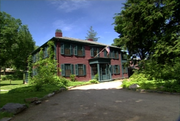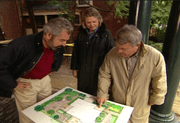Hi, I'm Bob Vila.
Welcome home again.
Well, the job isn't quite done, but like millions of Americans who remodel their own homes, the Vilas are moving in .
We've got the first load right here.
We've got lots to talk about today.
The interior designers are here, and they're showing some of their ideas for colors, fabrics and wallpapers.
Also, we've got Reilly, and we've got Danny working up front on one of the most essential features to any the remodeling jobs; new front steps and a railing around the front porch, and most exiting, I'm starting to move into my basement workshop.
Stick around, its good to have home again.
Bob Vila' s Home Again.
Let's get started meeting Susan Tongor and Christine Lane, our Interior Designers from CLC here in Boston.
Hi, Bob.
Ladies, how are ya?
Good.
How are you doing?
I'm great.
I'm happy to see you.
This is the first time you have actually been here with me in front of the camera, but you've been working behind the scenes for months, right?
Yes.
Oh, absolutely, and you know that's really important that we start early in the process, because all the product from the fabric to the furniture to the window treatment really has a long lead time So it's important that we start early on.
But Christine, the role of the interior designer isn't just ordering stuff, right?
Right.
Typically what we do is we start with the floor plan, which you can see here.
And then you have a lot of gorgeous rugs that you've collected and antique furniture.
So what was we've plugged in your existing furniture along with some new pieces.
Yeah, when you're working with somebody as old as I am, we already have a bunch of stuff in the back ground and we're coming from another house.
So, you've helped us inventory, what we have and figure out what to use and what to replace.
Right, right.
Yeah .
So we're in our dining room here, and you've laid out the furniture placement in terms of a rug that we've had forever .
And it's a small dinning room,so there is really only room for the rug, a table and some chairs.
And of course we have our built in hutch.
But let's talk a little bit about the colors and things you've chosen for the dining room.
Well, the starting point was your beautiful area rug.
And then from there we went on to this William Morris wall paper, which is very typical of this style and period of house.
Late 1880's and 90's.
Right, right.
And William Morris was this fantastic Englishmen who created unbelievable designs.
Tell me a little bit about how this paper is made.
It's an arts and craft paper , and it's done with hemp blocks, out of pear wood blocks, and it has eight different colors, and everyday a different color is put on so it's really an eight day process.
So this is still done in the exact same way that it was done in the 19th century.
Right, exactly.
And also because of that it tends to be a little bit expensive so what we recommend, Bob, is to have it above the chair rail, and use the paint color below.
So you chose this color here, this blue, which is in the paper.
Yeah, that's right.
And, what you've done, well, you can see right behind you here, Cristine what you've done is spec the paint below the dado, the chair rail, and then the expensive paper on a wall.
That's right.
But we have large windows too
What about this table that you've got in the picture here?
Well, you haven't selected a dining room table, but this is what we would recommend.
This is a neoclassical Bedamar style table.
Mm-hm.
And the scale of it is nice.
This dining room is more of a cozy scale.
And this table will allow you to expand it with leaves so that for larger dinner parties, you can accommodate all the seating.
Mm-hm.
And a Bedamar style chair would look very handsome with it.
Mm-hm.
And you've chosen fabrics.
This is really is really neat.
Tell us a little bit about that.
This is a glazed chintz fabric.
Mm-hm.
And it has an Asian motif on it which is very handsome.
Yeah.
And the color also picks up the color of the berry in the William Morris wall covering.
Right.
Subtle little things like that, that really key a room and help bring it together.
That's right, so it really pulls it together so that the concept is nice and tight.
Okay, well looking back at the floor plan, you've taken advantage of, as we said a minute ago, rugs that I've got.
Over the years.
My wife and I found this rug actually on a trip a few years ago.
in Greece.
That's right.
And you're gonna put that in the front hall.
Right.
And this one, we've had forever.
And you're gonna put that in the living room.
In the living room, right.
Okay.
And the paper that you've chosen for the front hall is interesting.
Because , again, it's a William Morris, right?
That's right.
And this is what they call his chrysanthemum pattern.
And you can see it's a beautiful leafy pattern -- very typical of his style.
And the important thing here is to make sure that you have light woodwork when you're using a paper like this.
That's right Bob, because it really makes a nice contrast, and it keeps a very fresh palette in the space.
But I love the stain color that we chose for the floor.
Oh yes -- very handsome.
We have the details put in.
But when you have that red against the floor, and it's done, it's gonna be gorgeous.
It's very rich.
Let's take a look in the library.
Okay, great.
Now, in this room, obviously, we've got the proportions from the original house, which are not a square, but rather a cut off corner with a fireplace.
And then we've got our architectural renovation.
Which includes some details like this beautiful library wall that we're just finishing up, and the new floor that we installed, which is essentially an oak herringbone.
And tell us a little bit about what your job was here.
Okay.
What we wanted to create in this room is a very warm, cozy room, so you'd feel very comfortable in the snowstorm in the middle of winter.
So, what we did is we took this mahogany and put a red mahogany stain on it to make it very rich and enticing.
And then for the floor, we did the same thing.
We put the red mahogany stain, which is a slightly lighter color than the red mahogany.
Yeah.
And, of course, the mahogany carries around the whole room with the cornice molding.
The walls have just gotten a coat of this red paint.
What happens next?
Well, what we're suggesting is doing a parchment finish, or a striae finish, so it has a kind of Pompeii-ish red look.
So that involves ragging, or glazing, or what?
Right.
It involves glazing think so it brings and we've layered the colors so it becomes very rich.
It is going to be a special paint job, yeah.
Right.
And then you've chosen some fabrics as well.
That's right, this is also very beautiful.
It's a Moire damask and we will be putting this on the two upholstered chairs that will be on the angle coming off of the fireplace, which will create a really nice seating area for those cold winters, fire, two chairs, and an ottoman.
And the only thing I had that I definitely was bringing was a big library table.
That's right.
Which will be my work table when I'm here.
That's right.
Good.
I can't wait for it all to come together.
Yeah, it's going to be great.
Its going to look really wonderful.
Thanks for your help.
Thank you.
We've got to break for messages.
Don't go away.







